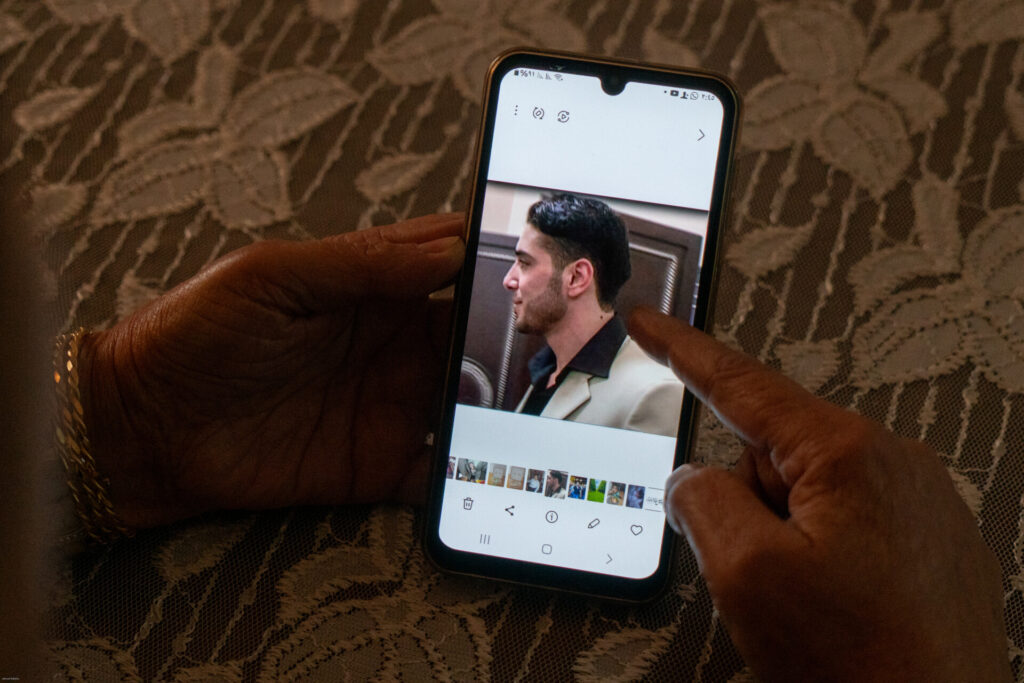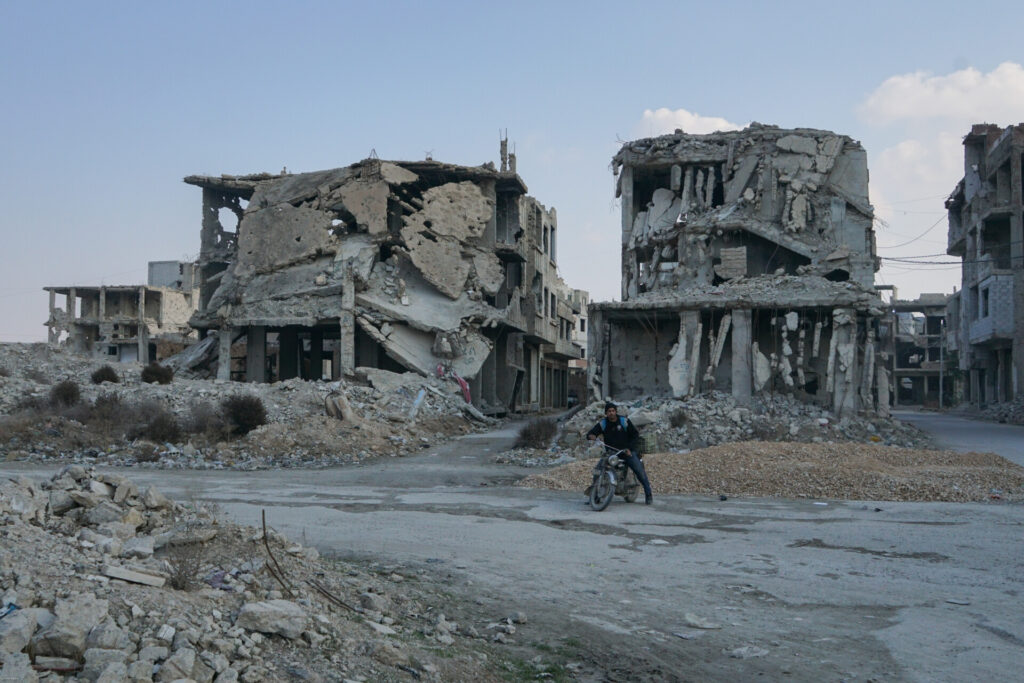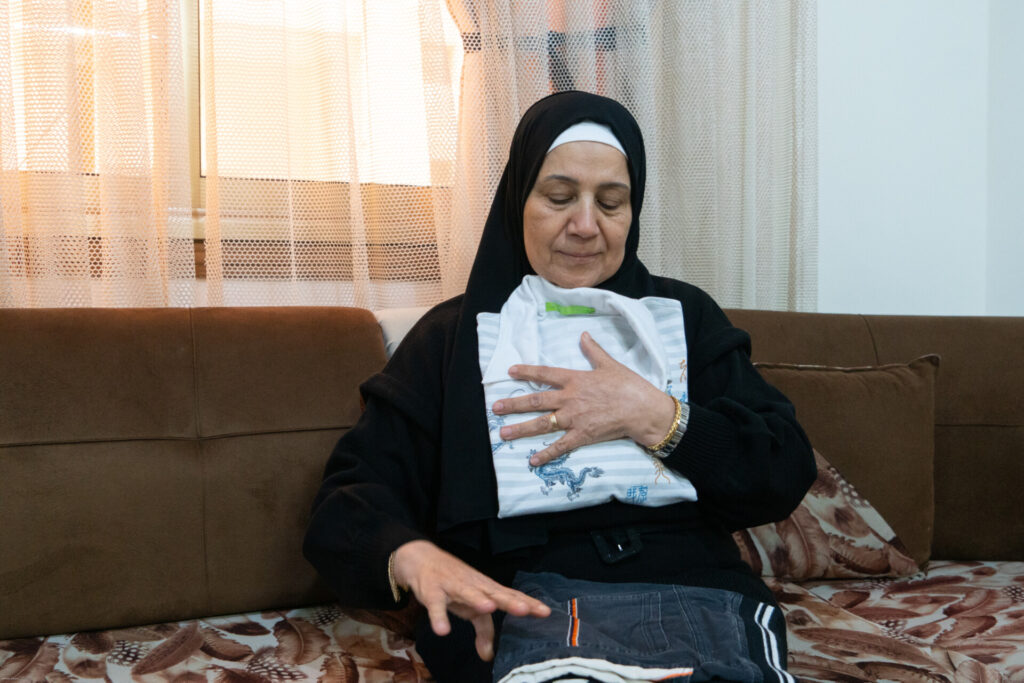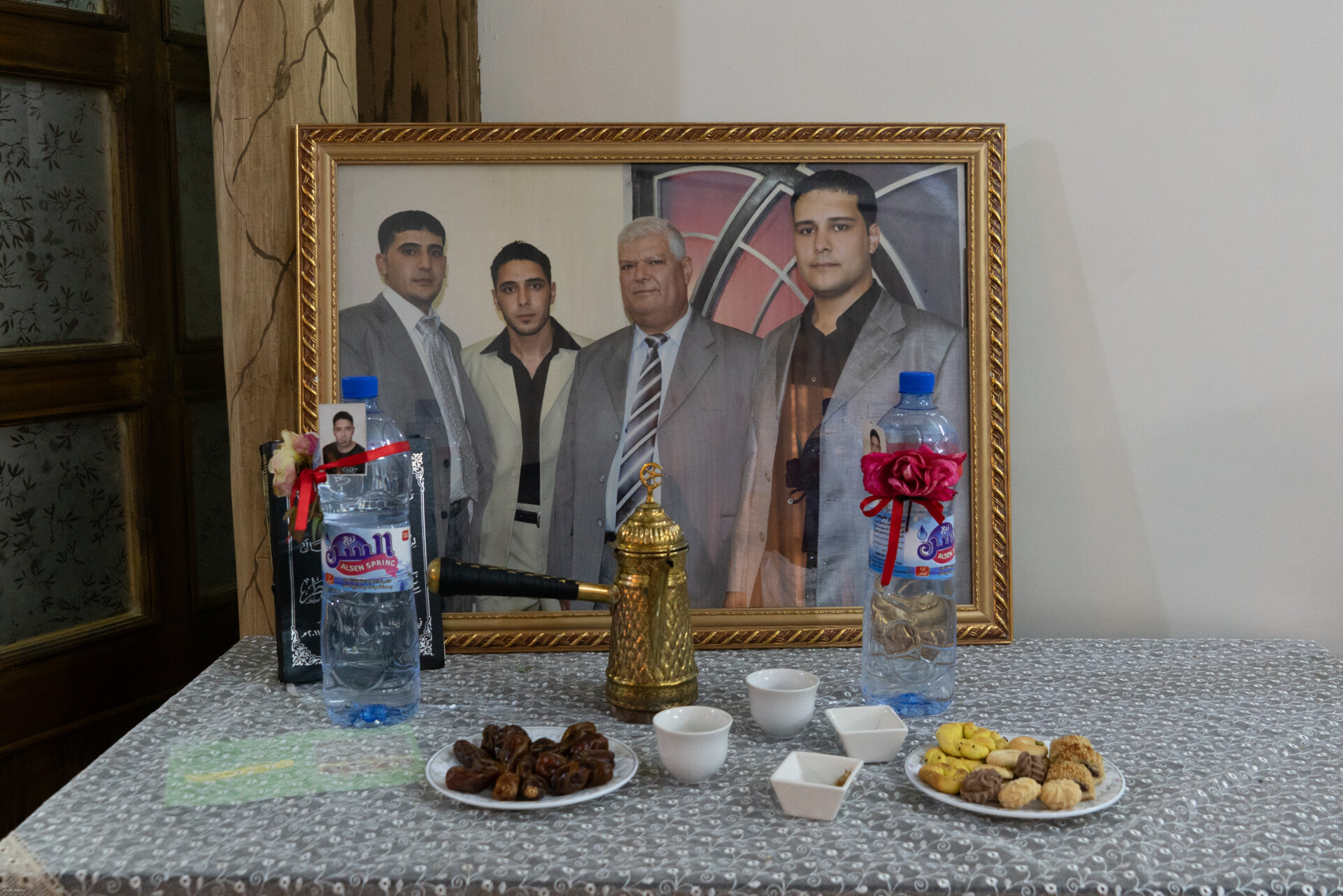For the first time in 14 years, Mayada Mattar is serving plates of sweets — turmeric-tinged fennel biscuits, date-stuffed sesame rolls and petit fours — a tradition in Arab homes at times of celebration. But this time, the celebration is bittersweet.
“Ghiyath said, ‘When the regime falls, please serve sweets,’” Mayada says of her son, as she offers the plate around the room. “I wish that my children were with us to live this happiness, since Ghiyath and his friends sacrificed themselves. I wish they could see the victory that they fought for years ago.”
Next to the plates, on a table in the front room of their apartment in the Damascus suburb of Darayya, is an enlarged photograph of her husband, Tayseer Mattar, and their three adult sons: Ghiyath, Hazam and Anas.
Ghiyath, at 26, became an unwitting symbol of the Syrian revolution, which erupted when hundreds of thousands took to the streets in March 2011, calling for an end to Bashar al-Assad’s rule and demanding dignity, rights and freedom after decades of oppression under his Baath party.
Darayya was one of the first towns to mobilize, and with its history of civil activism, it quickly saw thousands take to the streets every week after Friday prayers, stoking the anger of the government’s security forces.
The demonstrators, led by Ghiyath and two other young men, Islam Dabbas and Yahya Shurbaji, were armed with roses, water bottles and letters of peace for the regime soldiers sent to police the demonstrations.
Their symbolic acts of peace would be replicated in cities across Syria during those first months of demonstrations, which continued into the summer of 2011, well before anyone knew of the horror that was to come.

The young men’s demands for civil rights and the widespread appeal of their flower campaign would see them and their families targeted and harassed by the government security apparatus. All three men were arrested in 2011 and eventually killed in the custody of regime authorities.
Ghiyath and Shurbaji were detained together on Sept. 6, 2011. Four days later, Ghiyath’s mutilated body was dumped on the doorstep of the family home. His wife would give birth to their son, also named Ghiyath, two months later.
The elder Ghiyath’s violent death marked a turning point in the revolution and sent shockwaves through the community and further afield. Thousands of people came to his funeral, including the French, German and American ambassadors.
Newspaper reports from the time document growing concern from the international community over the increasing violence deployed by Assad’s security forces. Later that year, the French and U.S. ambassadors would be pulled out of Syria when their embassies were attacked by pro-Assad groups after the diplomats attended a demonstration in the central city of Hama.
Ghiyath would be feted and a documentary made about him, with organizations set up in his memory still operating to this day.
Ghiyath and Shurbaji are among 136,614 people who were detained or forcibly disappeared by regime forces from March 2011 to August 2024, according to the U.K.-based Syrian Network for Human Rights. The activists were also among the estimated 231,495 civilians who died over the same time period.
Hanging over the Mattar family, and many others, as they come to terms with the collapse of the Assad regime, is the question of justice. Many are watching to see if the new interim authorities led by Ahmad al-Sharaa of the Islamist group Hayat Tahrir al-Sham (HTS) can lay the foundation for an inclusive, democratic and free state — the kind their sons called for when they led demonstrations 14 years ago.
The sprawling suburb to the southwest of Damascus, known for its furniture workshops and fruit trees, was subjected to some of the war’s worst atrocities. In August 2012, at least 700 people were killed when forces loyal to the Syrian regime stormed the town in a mighty aerial and ground bombing campaign.

It was besieged over the next four years, leaving thousands of residents trapped, as battles raged between Assad loyalists and opposition militia groups led by local branches of the Free Syrian Army.
Hasan Hadle survived the siege but suffered a serious leg injury from shelling in 2016. As a teenager, he joined the demonstrations in his hometown, which, he says, “never believed in violence.”
“The crowds sometimes reached hundreds of thousands, defying fear and oppression, holding onto our belief that freedom was worth all these sacrifices,” the 24-year-old writes to me from Austria, where he now lives and receives medical treatment for his leg injury.
He remembers Ghiyath as a “model of humanity and courage,” who was “deeply convinced that change could not be achieved through violence, but rather through patience, steadfastness and principles.”
Like Hadle’s wound, Darayya has not healed. When I visit, swaths of the town remain a crumpled mess. A few palm trees poke through the mounds of concrete dust, brick and rubbish. The broken minarets of Sayyida Sakina shrine hang against the sky, a meager landmark offering a glimpse of what the town’s skyline used to be. Today, it is instead shaped by skeletal apartment blocks that protrude wire and mesh, with a sprinkling of ground-floor shops that operate with pockmarked facades.
Inside the Mattars’ apartment, Tayseer and Mayada are paying the price for their sons’ bravery, beliefs and nonviolent fight for a better Syria. Meeting one month after the fall of Assad, their feelings of celebration are muted. “They were the bridge that led us to be free,” Mayada, 62, says. “I hope that everything will be as they dreamed of, as they hoped.”
Tayseer says that today the fear that dominated their lives is gone. “Fifty-four years of suffering was solved in 13 days without any bloodshed,” he says, referring to the shock incursion by HTS fighters through Aleppo, Homs and Hama, which culminated in the capture of Damascus last December.
The interim government led by HTS — which is known for its rule of Idlib as the Nusra Front and its past affiliation with al Qaeda — represents an opportunity for justice for the tens of thousands of victims of the Assad regime.
“We can’t forgive the regime, but we also won’t take revenge by ourselves; we want them to go to court and stand trial,” Tayseer says. If that were to happen, they would be seeking justice for the deaths of their three sons.
It took seven years for the family to learn that 27-year-old Hazam had been taken to the brutal Sednaya military prison, where torture was well-documented. His mother says his crime “was being Ghiyath’s brother.”
In 2013, their eldest son, 28-year-old Anas, was arrested and disappeared. His parents desperately searched for him. Tayseer described how he would look at torture videos from inside the prisons that had been shared online, watching excruciating scenes just in case he caught a glimpse or clue of Anas.
In December, when the prisons were opened in the dramatic aftermath of the HTS takeover, Mayada and Tayseer could not bear to visit the cells their sons may have been kept in. When they heard the stories and saw the images of the torture machines at Sednaya, they prayed that Anas died before he was taken there.

For years, Syrian and international rights groups have been documenting atrocities from whistleblowers and victims, but no one could imagine the horrors that came to light in the days and weeks that followed Assad’s fall, when the curtains were pulled back on decades of abuse.
Bassam Alahmad, the director of Syrians for Truth and Justice, explains that the sheer volume of atrocities presents a huge challenge to the healing process.
“I think our main message to families of victims is to know it will not happen between one day and the other,” Alahmad says. He also points out that Syria’s current judicial system is not fit to deal with such serious allegations like war crimes and crimes against humanity.
“We don’t have the legal framework or infrastructure, nor are people trained in it,” he says, adding that the courts are not currently operating, and the dire economy is a further setback.
Alahmad believes that a hybrid judicial system, “between Syrian and international,” could be suitable, as could the country joining the International Criminal Court. His remarks match those of other legal experts, who have highlighted how international jurisdiction allows courts outside Syria to adjudicate crimes committed inside the country.
At the long-awaited national dialogue conference in February, al-Sharaa announced the formation of a committee on transitional justice. There is additional support from international bodies like the U.N.’s Independent Institution on Missing Persons in the Syrian Arab Republic, whose director, Karla Quintana, visited Syria in February.
Transitional justice, however long it may take, is seen as integral to the country’s next chapter. But whether everyone will be able to wait remains an open question. Al-Sharaa has urged civilians not to take matters into their own hands following reports of sporadic revenge attacks against individuals allegedly aligned with the previous regime.
Abdulrahman Dabbas was a friend of Hazam Mattar and the younger brother of Islam Dabbas — Ghiyath Mattar’s friend and fellow activist. Islam was 21 when he was arrested by the government security forces and disappeared in July 2011, just two months before the security forces took Ghiyath. It was not until 2018 that the Dabbas family discovered that Islam had been executed in Sednaya five years earlier.
Abdulrahman, who now lives in France and works for an open-source investigative organization, says his and other families are desperate to know where their loved ones’ bodies are.
“Ok we know they died, but where are their bodies? We want to know what happened to them, what was the last thing they ate, what were they wearing; we are looking for the whole story,” the 29-year-old says.
For families and friends of activists, the path ahead must ensure that the demands of the revolution’s martyrs are not forgotten. Hadle knows the challenge is immense. He says his trauma from living through Darayya’s siege means he is not ready to return. “The wounds are yet to heal,” he says.
But he adds: “Hope remains alive, especially with a new generation that has grown up with the values of freedom and justice, a generation that will never allow tyranny to return and will carry the torch of change.”
That torch was carried by Ghiyath, Islam and other Darayya activists who became icons for holding flowers in the face of aggression. Today, the torch needs new carriers. Yet for the likes of Abdulrahman and Hadle, who were teenagers during the war, a return to Syria from their refuge in Europe is not straightforward.
For now, Abdulrahman says, freedom is being felt by their elderly fathers. After their lives were gripped by the iron fist of the Assad family for over 50 years, the men are back on the streets of Darayya, tasting the new air of a nation allowed to breathe again.
“Spotlight” is a newsletter about underreported cultural trends and news from around the world, emailed to subscribers twice a week. Sign up here.



